Bilateral Serous Retinal Detachment as a Complication of HELLP Syndrome
Abstract
Author Contributions
Funding
Institutional Review Board Statement
Informed Consent Statement
Data Availability Statement
Conflicts of Interest
References
- Schönfeld, C.L. Bilateral Exudative Retinal Detachment in HELLP Syndrome. Case Rep. Ophthalmol. 2012, 3, 35–37. [Google Scholar] [CrossRef]
- Sibai, B.M.; Taslimi, M.M.; el-Nazer, A.; Amon, E.; Mabie, B.C.; Ryan, G.M. Maternal-perinatal outcome associated with the syndrome of hemolysis elevated liver enzymes, and low platelets in severe preeclampsia-eclampsia. Am. J. Obstet. Gynecol 1986, 155, 501–509. [Google Scholar] [CrossRef] [PubMed]
- Naderan, M. Ocular changes during pregnancy. J. Curr. Ophthalmol. 2018, 30, 202–210. [Google Scholar] [CrossRef] [PubMed]
- Abdellaoui, T.; Bouayad, G.; Elkhoyaali, A. Bilateral Serous Retinal Detachment complicating Preeclampsia. Indian J. Med. Spec. 2018, 9, 36–39. [Google Scholar] [CrossRef]
- Teodoru, C.A.; Munteanu, M.; Mercea, N.; Moatar, A.; Stanca, H.; Popescu, F.G.; Dura, H.; Hașegan, A.; Giurgiu, D.I.; Cerghedean-Florea, M.-E. Ophthalmic Vein Thrombosis Associated with Factor V Leiden and MTHFR Mutations. Diagnostics 2023, 13, 1052. [Google Scholar] [CrossRef] [PubMed]
- Stanca, H.T.; Tăbăcaru, B.; Baltă, F.; Mălăescu, M.; Stanca, S.; Munteanu, M.; Dărăbuș, D.; Roșca, C.; Teodoru, A.C. Cumulative visual impact of two coagulability disorders: A case report. Exp. Ther. Med. 2020, 20, 218. [Google Scholar] [CrossRef] [PubMed]
- Villalba-Pinto, L.; Hernández-Ortega, M.Á.; de Los Mozos, F.J.; Pascual-Camps, I.; Dolz-Marco, R.; Arevalo, J.F.; Gallego-Pinazo, R. Massive bilateral serous retinal detachment in a case of hypertensive chorioretinopathy. Case Rep. Ophthalmol. 2014, 5, 190–194. [Google Scholar] [CrossRef] [PubMed]
- Bourke, K.; Patel, M.R.; Prisant, L.M.; Marcus, D.M. Hypertensive choroidopathy. J. Clin. Hypertens. 2004, 6, 471–472. [Google Scholar] [CrossRef] [PubMed]
- Khallouli, A.; Choura, R.; Saidane, R.; Gouider, D.; Maalej, A.; Rannen, R. Bilateral exudative retinal detachment in HELLP syndrome, first description in North Africa: A case report. PAMJ 2021, 39, 6. [Google Scholar] [CrossRef]
- Tony, C.; Neelakshi, B. Serial OCT Imaging of Retina in HELLP Syndrome. ASOP 2020, 3, 24–28. [Google Scholar]
- Katsimpris, J.M.; Theoulakis, P.E.; Manolopoulou, P.; Brinkmann, C.K.; Gatzogias, M.I.; Petropoulos, I.K. Bilateral serous retinal detachment in a case of preeclampsia. Klin. Monbl. Augenheilkd. 2009, 226, 352–354. [Google Scholar] [CrossRef] [PubMed]
- Younis, M.T.; McKibbin, M.; Wright, A. Bilateral exudative retinal detachment causing blindness in severe pre-eclampsia. J. Obstet. Gynaecol. 2007, 27, 847–848. [Google Scholar] [CrossRef] [PubMed]
- Păun, V.A.; Ionescu, Z.R.; Voinea, L.; Cîrstoiu, M.; Baroș, A.; Pricopie, Ș.; Ciuluvică, R. Ocular posterior pole pathological modifications related to complicated pregnancy. Rom. J. Ophthalmol. 2017, 61, 83–89. [Google Scholar] [CrossRef] [PubMed]
- Mao, M.; Chen, C. Corticosteroid Therapy for Management of Hemolysis, Elevated Liver Enzymes, and Low Platelet Count (HELLP) Syndrome: A Meta-Analysis. Med. Sci. Monit. 2015, 21, 3777–3783. [Google Scholar] [CrossRef] [PubMed]
- Gupta, B.; Singh, N.; Kumar, V.; Rajaram, S.; Goel, N. Bilateral exudative retinal detachment in a patient with early onset severe preeclampsia. Pregnancy Hypertens. 2014, 4, 253–254. [Google Scholar] [CrossRef] [PubMed]
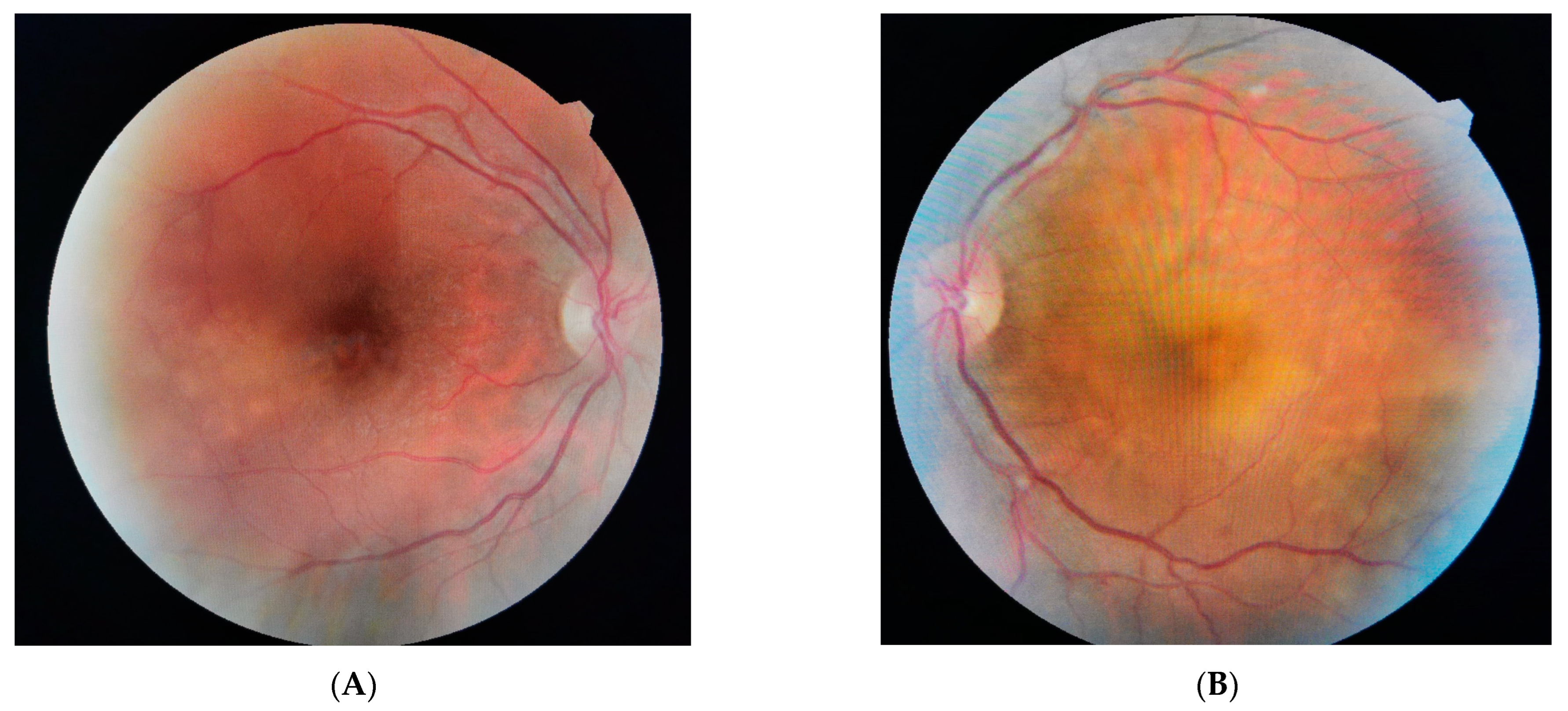
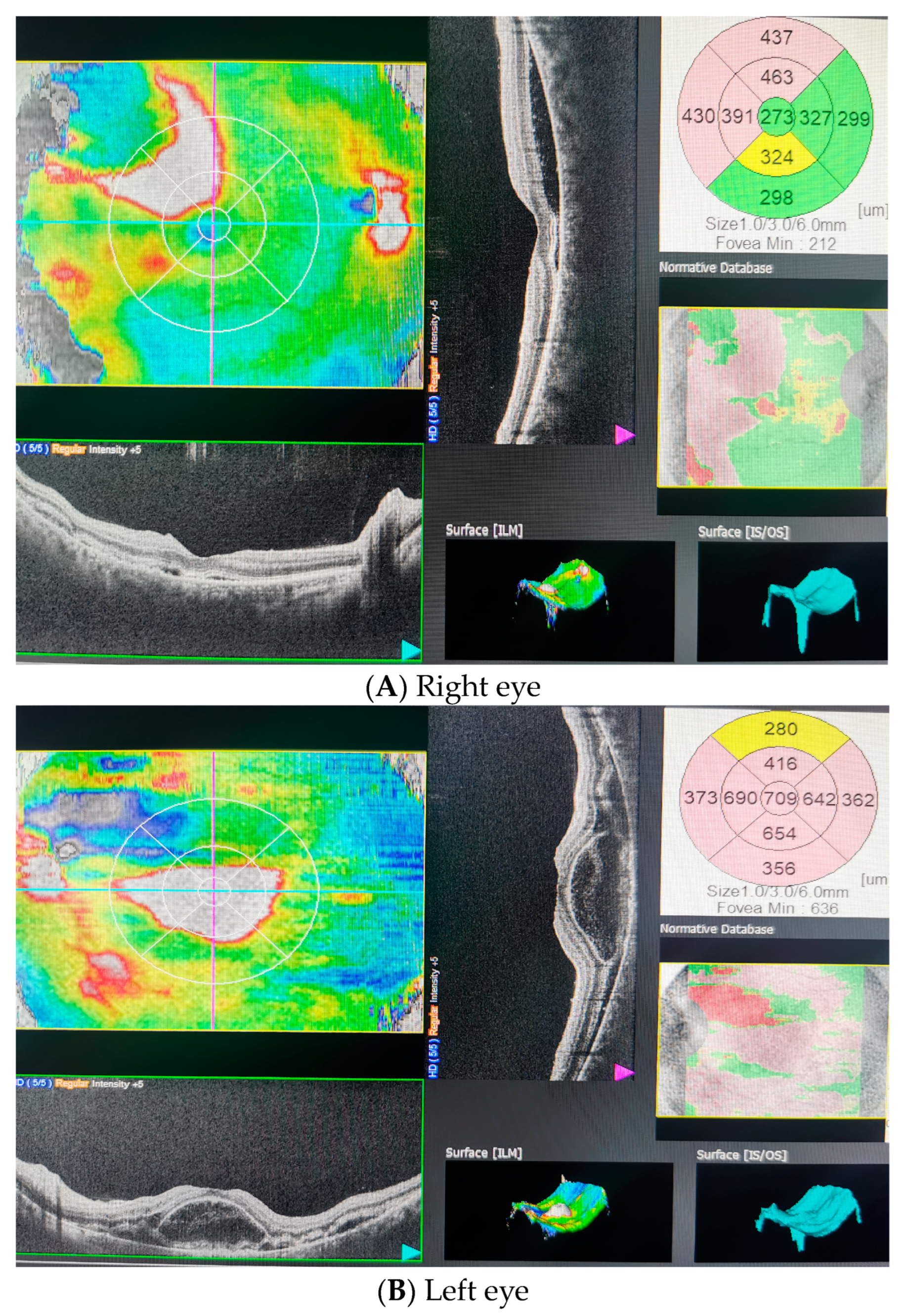
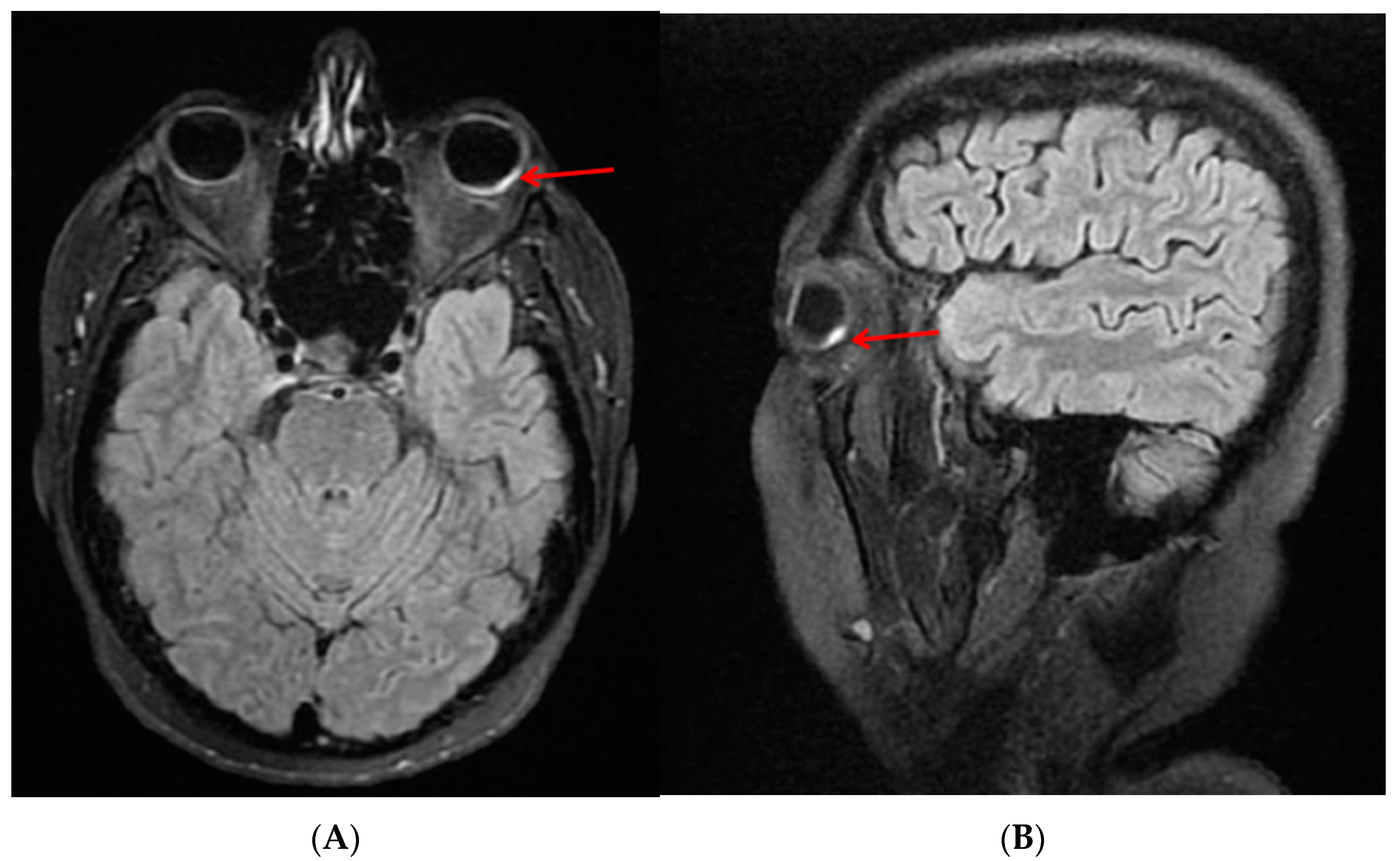
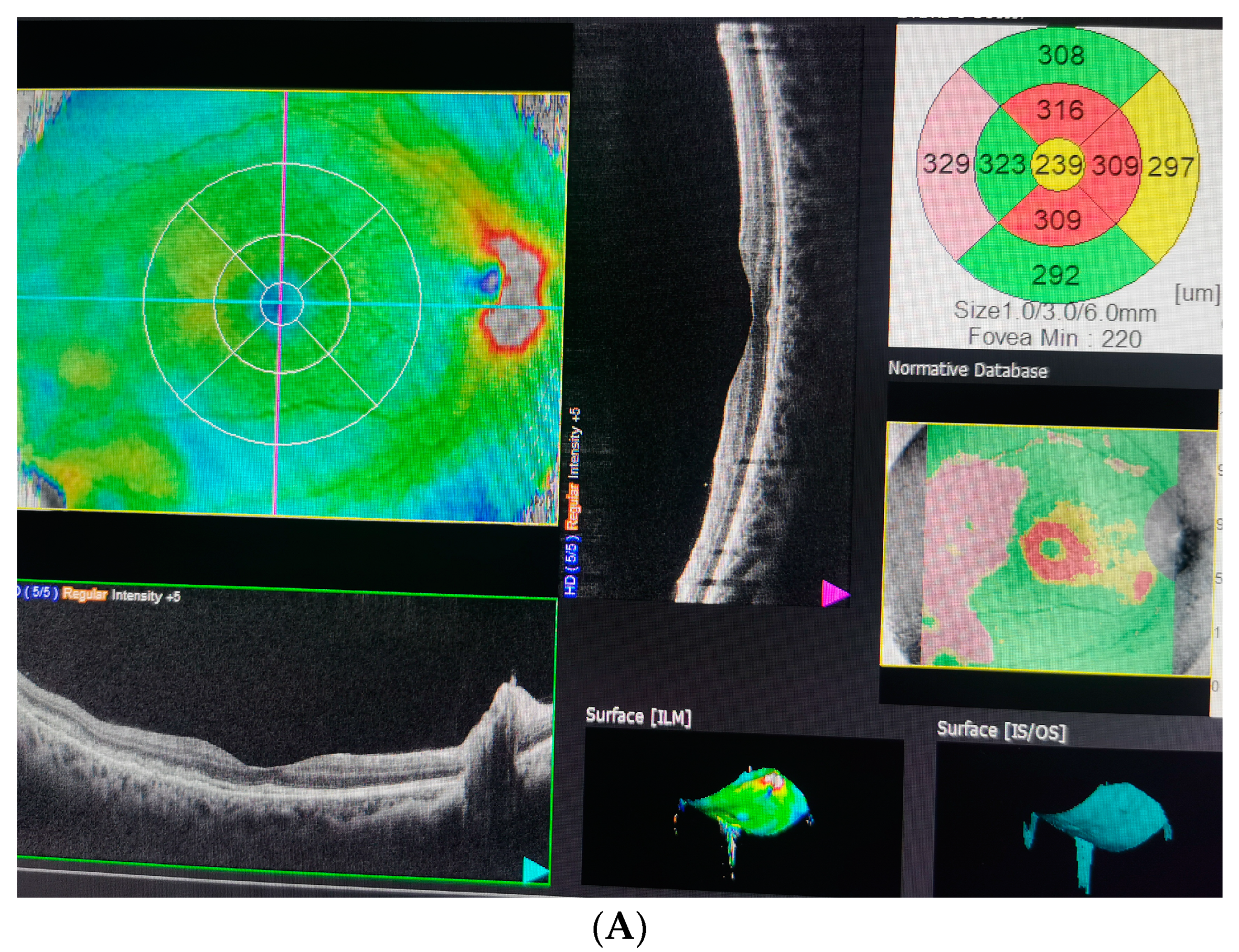

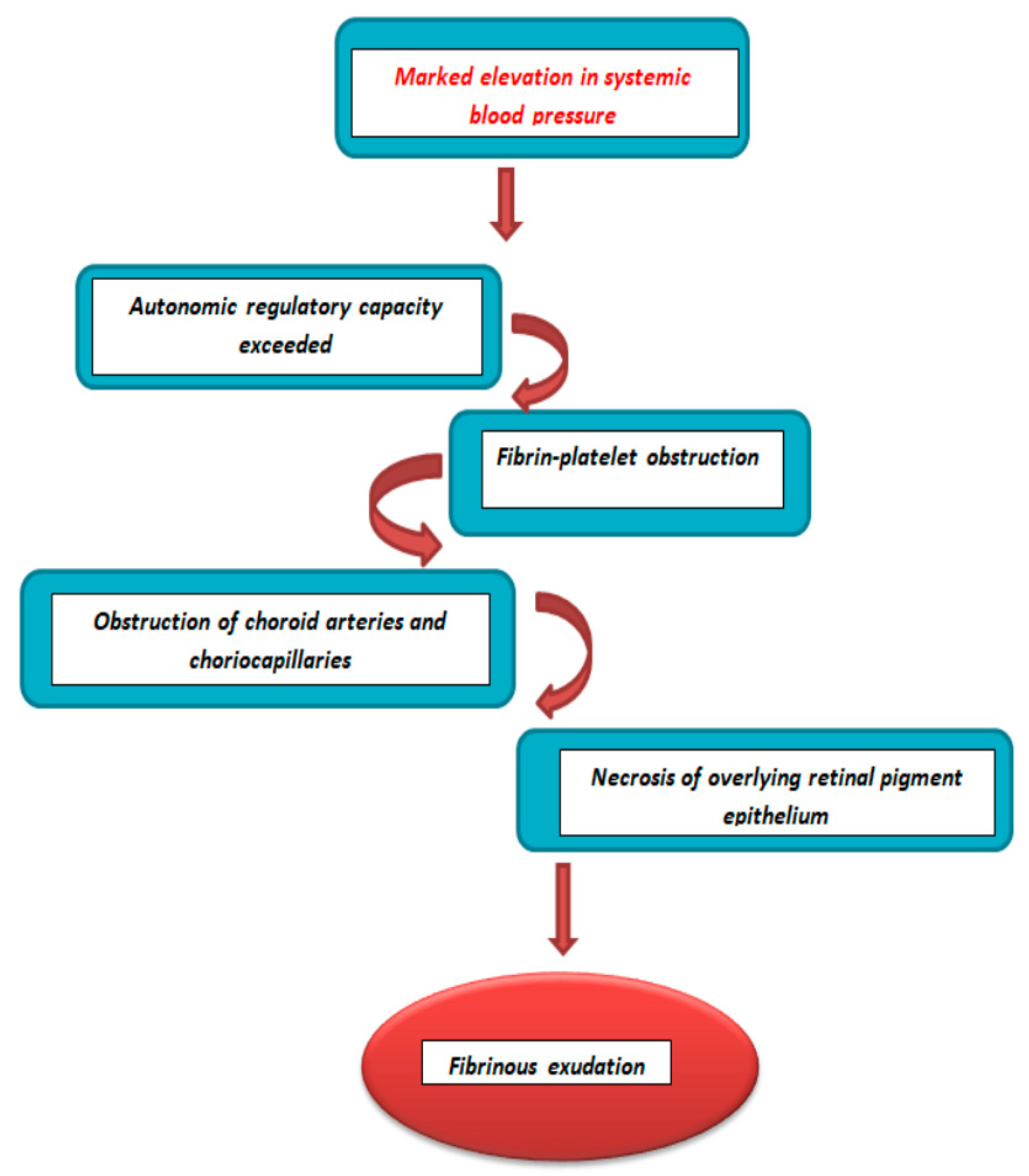
| Laboratory | Results |
|---|---|
| PCR (0–5 mg/dL) | 102 mg/dL |
| Fibrinogen (179–420 mg/dL) | 706 mg/dL |
| Procalcitonin (0–0.05 ng/mL) | 2.74 ng/mL |
| D-dimers (45–499 ng/dL) | 9560 ng/dL |
| Fibrinogen (170–420 mg/dL) | 705 mg/dL |
| International Normalized Ratio (INR) (0.86–1.1) | 1.23 |
| Thrombocytopenia (150–400 × 103) | 71 × 103/mm3 |
| Alanine aminotransferase (ALT) (0–34 UI/L) | 194 UI/L |
| Aspartate aminotransferase (AST) (11–34 UI/L) | 188 UI/L |
| Lactate dehydrogenase (LDH) (125–220 UI/L) | 898 UI/L |
Disclaimer/Publisher’s Note: The statements, opinions and data contained in all publications are solely those of the individual author(s) and contributor(s) and not of MDPI and/or the editor(s). MDPI and/or the editor(s) disclaim responsibility for any injury to people or property resulting from any ideas, methods, instructions or products referred to in the content. |
© 2023 by the authors. Licensee MDPI, Basel, Switzerland. This article is an open access article distributed under the terms and conditions of the Creative Commons Attribution (CC BY) license (https://creativecommons.org/licenses/by/4.0/).
Share and Cite
Teodoru, C.A.; Tudor, C.; Cerghedean-Florea, M.-E.; Dura, H.; Tănăsescu, C.; Roman, M.D.; Hașegan, A.; Munteanu, M.; Popa, C.; Vică, M.L.; et al. Bilateral Serous Retinal Detachment as a Complication of HELLP Syndrome. Diagnostics 2023, 13, 1548. https://doi.org/10.3390/diagnostics13091548
Teodoru CA, Tudor C, Cerghedean-Florea M-E, Dura H, Tănăsescu C, Roman MD, Hașegan A, Munteanu M, Popa C, Vică ML, et al. Bilateral Serous Retinal Detachment as a Complication of HELLP Syndrome. Diagnostics. 2023; 13(9):1548. https://doi.org/10.3390/diagnostics13091548
Chicago/Turabian StyleTeodoru, Cosmin Adrian, Corina Tudor, Maria-Emilia Cerghedean-Florea, Horațiu Dura, Ciprian Tănăsescu, Mihai Dan Roman, Adrian Hașegan, Mihnea Munteanu, Carmen Popa, Mihaela Laura Vică, and et al. 2023. "Bilateral Serous Retinal Detachment as a Complication of HELLP Syndrome" Diagnostics 13, no. 9: 1548. https://doi.org/10.3390/diagnostics13091548
APA StyleTeodoru, C. A., Tudor, C., Cerghedean-Florea, M.-E., Dura, H., Tănăsescu, C., Roman, M. D., Hașegan, A., Munteanu, M., Popa, C., Vică, M. L., Matei, H. V., & Stanca, H. (2023). Bilateral Serous Retinal Detachment as a Complication of HELLP Syndrome. Diagnostics, 13(9), 1548. https://doi.org/10.3390/diagnostics13091548









